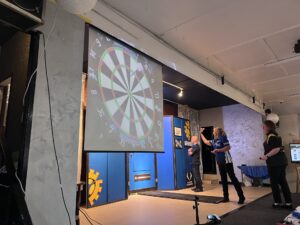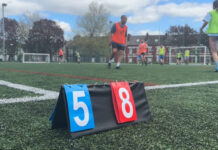In a sport that is based on precision rather than strength, you would think that men and women would be on an equal level.
However, this has been far from the case. Women have had to fight for visibility in a sport traditionally dominated by men.
But the females of the Merseyside Darts organisation are working towards closing the gender gap.
They compete in the ladies Super League on Friday evenings against each other and represent Merseyside in the United Kingdom Darts Association (UKDA) league against other County teams in England.
However, the divide is apparent. County matches are played across a weekend, with six players per women’s team compared to twelve players per men’s team, a reinforcement of the idea that it is a male dominated sport.
The history behind the gender divide

Darts rose to popularity during and after the Second World War, but it was typically a pub pastime heavily associated with the drinking culture, meaning that it wasn’t a very accessible environment for young women.
In 1963, a housewife from Lancaster applied to join the local darts league to be told that it was ‘men only’ and it wasn’t until the 1970s that women’s darts was recognised, with the founding of the British Darts Organisation in 1973. Six years later, the first singles competition at the British Open was won by Englishwoman Judy Campbell.
Janet Hardman has been playing for Merseyside Darts since 1985 and is one of their longest standing players, so she has experienced the challenges of a female darts player. She described her experience as ‘tough at times’ as a woman in a male-dominated sport.
For newer players like Molly Brash, the divide isn’t so noticeable.
Molly said: “For me, I’ve not really noticed much because I am still quite new to it. On a Thursday I play for a women’s league, on a Friday I play for a men’s team and I’ve always been welcome there.
“There are a few oppositions that pull a face and say why do I have to play a woman, but other than that, I’ve not had anything major.”
The rise of female darts stars
In recent years, female darts players have become an inspiration for young women, encouraging them to get involved.
Fallon Sherrock, known as ‘The Queen of the Palace’ made history in 2019 by becoming the first woman to win a match at the PDC World Darts Championships. She progressed to the third round where she lost out to Chris Dobey, but it was a huge step for increasing the visibility of women’s darts.
21-year-old Beau Greaves has also started to transform women’s darts and is currently the female world number one. This year, she became the first woman to reach the fourth round of the UK Open before being beaten by the men’s world number one Luke Humphries.
Sandra Rule, who has been playing darts for 53 years and for Merseyside the last eight years, believes these role models have had an impact on the younger generation.
These players have shown that females can perform at the highest level, helping to raise the profile of women’s darts, and inspiring young girls.
The Luke Littler effect:
The popularity and success of 18-year-old Luke Littler has also attracted a ‘new generation’ of darts fans and players.
Two years ago, he was almost unheard of, but now he has become a household name.
Nicknamed Luke ‘The Nuke’ Littler, he became the youngest ever World Darts Champion, defeating Michael van Gerwen 7-3 in the 2024/25 final.
Littler’s breakout at just 16 has ‘made darts cool again’ and is now reaching audiences that it never has before, particularly young people, including young girls.
Sandra has just opened the Luke Littler Darts Academy in Warrington, which is for youngsters aged between seven and 18.
There are seven young girls who currently train there, and she said some have real potential and that it’s nice to see one of the girls actually beating one of the guys.
Despite the increase in the number of females playing darts, there is still a long way to go for women to be on an equal playing field to men.
The continuing battle:
Many factors have contributed to why women’s darts is under-represented, especially when it comes to the professional game.
The media coverage that the women’s game receives in comparison to the men is next to none and Janet said it feels like they’re ‘an add-on’.
The first Professional Darts Corporation (PDC) women’s tournament to be fully televised was not until 2022, whereas men’s tournaments have been shown on TV since 1993-94.
Janet added: “I really do think that some of the ladies’ darts could be promoted more. It has come on so much in the last ten years, but I feel that they deserve a little bit more than what they get.”
The lack of media coverage for women’s darts makes it difficult for them to gain sponsorship opportunities. Even at a lower level, players have to pay to travel the country competing. Merseyside darts have had to spend around £10,000 this year travelling to away games, which has been paid for out of their own pockets.

There are also huge differences in prize money. Women earn significantly less than men at a professional level. The 2024/25 men’s PDC World Darts Championship saw the winner take home £500,000, with a total prize fund of £2.5 million.
In contrast, each event in the PDC Women’s Series, has a prize fund of £10,000, with £2,000 for each winner, and the Women’s World Matchplay holds a £25,000 purse with £10,000 to the winner.

Finally, there are less competition options for women, and it is rare to see them advance in mixed-gender competitions because they have fewer opportunities to succeed.
So, although women’s darts has grown in popularity, they are still far behind. Is this due to the standards not meeting those of their male counterparts, or is it just a lack of numbers and participation?
Featured image by Ellie Harker.

















